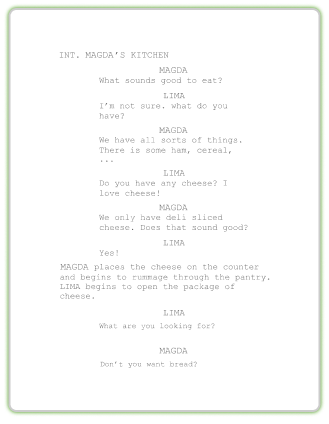With one click
Export a perfectly formatted traditional script.
Up and coming television writers may never find themselves on set.
Yep, you read that right. In the current era of the entertainment industry, the writer’s role and responsibilities have changed as budgets – and the length of a writers’ room – continue to shrink. And this isn’t just a bummer for your resume. Your wallet could suffer, too.
These are lessons that TV writer, novelist, and producer Stephanie K. Smith is learning first-hand. As someone who scored her first staff writer position back in 2016, Stephanie is watching her role as a television writer change before her eyes. And it has big implications.
Export a perfectly formatted traditional script.


But before we dive into that kind-of-sort-of lousy news, lets’ take a look at what a writer’s role used to be on set – and to some degree, still can be – to understand how writers have landed in the more common predicament they’re in now.
Traditionally, upper-level writers in a writers’ room with proven writing skills (usually a producer, co-executive producer, or higher) would be invited to be on set during the production of a television show, where their role would include ensuring the script is interpreted correctly and executing quick script additions or rewrites. Typically, this invite is reserved for the head writers who actually wrote the episode after the writing staff helped break and outline the story. These writers earn an additional fee for this work in addition to their work on the writing team. They also gain valuable time on set, where they’ll learn the ins and outs of production. This experience can help improve their writing when they move on to future rooms and help them make connections and build their network.
“In the old models, when it was that you go to work on an ABC show and it films on the lot, and you do 22 episodes over the course of 40 or whatever weeks, and it’s running a train, then everybody gets to go to set, and you learn your way around set,” Stephanie began. “And your hierarchy on set is commensurate with your title. You may be there as a writer, but they’re not going to send a staff writer there by themselves as a representative of that team. So, there are different things expected for how much set coverage you’ll do, and how much producing you’ll do, how much you’ll be in post, and all of that sort of stuff.”
But, this is where times are changing, Stephanie said.
“Unfortunately now, and this is an industry-wide problem, there are all of these short-order shows and shows where the writers are disconnected from production,” she said.
She recalled a recent television writing gig that required working for a 30-week mini-room, which, she explained, is hardly miniature. “Thirty weeks is a full season of television writing.”
A traditional writers’ room has a set amount of time and a typical number of episodes that need to be written, depending on the format. A mini-room in television is usually reserved for limited series or binge-able, streaming television where all episodes might launch at once. Often, no network or streaming platform has committed to ordering the show, so budgets and, therefore, timelines and number of writers are reduced to decrease risk. Mini-rooms are a good place for writers to get their foot in the door but a not-so-good place to earn a steady paycheck because the gigs are so short.
“Because the show wasn’t ordered until the room was over, they could then not pay any of the writers their producing fees. So, your title was really meaningless. Whatever you gave in the room was what you gave because nobody is going to set after except for the showrunner who’s the executive producer.”
So what TV writers’ titles meant on set initially has become slightly different than what it means now.
“And we have a dearth of people like me – mid- or approaching upper-level writers – who haven’t had a lot of set experience because they’ve done these shows that are done in a non-traditional fashion,” Stephanie said.
“Carnival Row,” for instance, where Stephanie was staff writer the first season and executive story editor the second season, was written in 2016. It got made in 2018, and it came out in 2019. The huge gaps in time between writing and production meant that Stephanie’s job was done long before production even took place.
“If they were going to send me, as a supervising producer, to set, I would understand them being like, “listen, we need somebody who is going to be guaranteed available come February or March,” but they don’t. They’re going to do a 20-week mini-room that’s going to be over, and by that point, if my show goes, I’d be done with my duties anyway. So, it’s a weird sort of antiquated system.”
Stephanie predicts that if things continue as they are – and so far, this looks likely if you consider the explosion of mini-rooms over the past few years – she said, “it’s very likely that there could be a writers’ strike in 2023 … because people are really getting pissed off.” She said that moving up the hierarchy in a writers’ room doesn’t mean much anymore, even for your bottom line. “There’s a big upheaval going on right now, led mostly by Netflix.”
Did you enjoy this blog post? Sharing is caring! We'd SO appreciate a share on your social platform of choice.
So, while streaming platforms such as Netflix have opened doors for new writers to have a place to go, they’ve closed other opportunities and made writing jobs more siloed. Ultimately, writers will need to decide what they want to do – write, or be on set – because, in the future, there may be no place to do both unless you’re the executive producer.
You win some, you lose some,